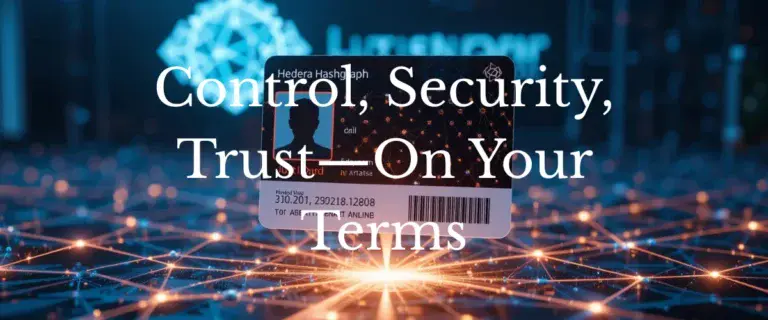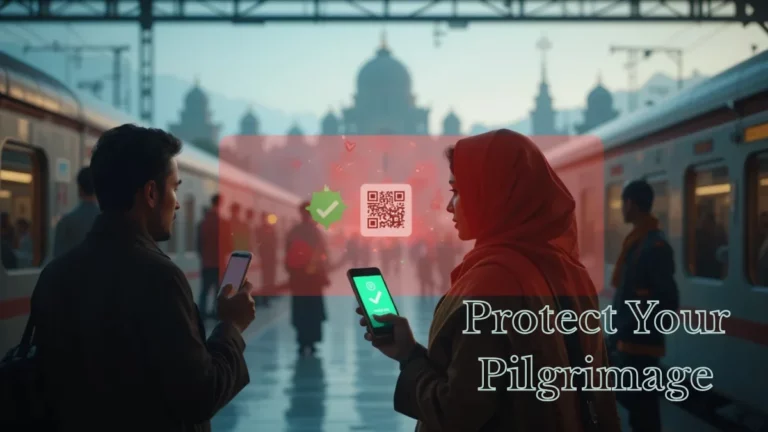Are You Tired of Your Personal Information Being Held Hostage by Big Tech?
The Urgent Need for Change
- Centralized Data Storage – Your identity is at risk with every data breach because it’s all stored in one place.
- Loss of Privacy – Companies profit off your data without your consent, using it for purposes you might not agree with.
- Identity Theft – Traditional methods like usernames and passwords are easily hacked, leaving you vulnerable.
- Lack of Control – You have little say in how your data is used once you’ve given it away.
Discover how decentralized identification (DID) with blockchain technology can:
- Give you back control over your personal data.
- Secure your identity from theft and breaches.
- Enhance your privacy online.
- Simplify your digital life across various platforms without compromising security.
Products to Consider
- Ledger Nano S/X: “Secure Your Digital Identity with a Ledger Wallet – Shop Now”
- NordVPN: “Protect Your Online Privacy with NordVPN – Get It Now”
Join the Web3 revolution! Secure your digital identity today and start enjoying the internet on your terms. Dive into this post to learn more about how decentralized identification can change your digital life forever.
Blockchain: The Backbone Of Decentralized Identification
Decentralized identification is one of those new terms from the world of Web3 that might sound strange at first. Remember when “social media” and “search engine” were new concepts that seemed complicated? Now, those terms are part of our everyday lives! Similarly, while “decentralized identification” may feel complex right now, it will soon become a familiar part of our internet vocabulary. Decentralized identification, often abbreviated as DID, refers to a system where individuals control their own digital identities using blockchain technology.
Think about the traditional Web2 ways we prove who we are online. You carry around driver’s licenses, passports, and a jumble of usernames and passwords. While these do the job, they come with problems. They get lost, stolen, or, even worse, hacked! It’s time for us to move beyond these outdated systems and embrace the promise of decentralized identification in Web3.
The goal of Web3 is to create a decentralized internet where you are in control of your own data. Decentralized identification is the key technology that makes this possible. It’s the foundation that supports the entire Web3 ecosystem.
Key Benefits of Decentralized Identification
- User Empowerment – Web3 aims to shift power back to you, allowing you to control your data and how you experience the internet.
-
- Online Purchases – When buying something online, you’ve probably entered your credit card details countless times, hoping the site is secure. With DID, you could use a digital wallet where you control what payment information is shared. You might verify you have sufficient funds or a valid payment method without revealing your card number or personal details to the merchant, reducing the risk of data breaches.
- Data Ownership – Data ownership in the context of decentralized identification (DID) means you control your personal information, not the companies. This translates into practical benefits like privacy by default, where you opt-in to share data rather than opt-out, reducing the risk of breaches since your data isn’t centralized.
-
- You can selectively disclose information, monetize your data if you choose, enjoy better security through cryptographic keys, and maintain the continuity of your digital identity across services. This control leads to a more trustworthy, less intrusive online experience, ensuring your data’s use is transparent and accountable to you.
- Interoperability – It creates a common way to manage digital identities, leading to a more connected and user-friendly online experience.
-
- Imagine traveling across multiple countries with just one digital identity. With decentralized identification (DID), you could use a single digital passport stored in your wallet to pass through borders, book hotels, rent cars, and engage in tourist activities without the hassle of re-verifying your identity at each step.
- This interoperability means your age, nationality, or driving credentials can be instantly confirmed across different services and countries, enhancing your travel experience by making it faster, more secure, and privacy-focused, as you control what information is shared and when.
In essence, decentralized identification lays the groundwork for a user-focused and decentralized internet. It empowers individuals with control over their digital identities, promoting a fairer and more trustworthy online environment.
Why Decentralized Identification is the Future of Our Digital Lives
With centralized systems, all of our information (yours, mine, everyone’s) sits in one spot—making it a sweet target for data breaches. Multiply this by all of the places that we frequent, and our data is deposited all over the websphere. Scary, right?
Well, this is where decentralized identification steps in to change the game. Decentralized Identification is our cryptic key to unlock our personalized impenetrable vault full of our data.
The high-tech version of an impenetrable vault is blockchain. Each person’s ID is divided into bits and scattered across a wide network. This means it’s much harder to steal and, even better, it’s always in your possession.
The world is already moving in this direction. I am helping to usher Web3 and blockchain in. Some places are experimenting with blockchain-based identification systems. They’re finding that not only is it more secure, but it also boosts efficiency and trust. We’re talking real life, real results, not just pie-in-the-sky ideas.
So, what do you take from this? Decentralized ID is the future. I am tired of letting these billion-dollar Web2 empires profit off of my data. It’s about time we took back control from the institutions holding our data hostage.
Understanding this shift doesn’t just make you savvy; it sets you up to be ahead of the curve in how we manage our identities in the digital age.
How Blockchain Functions as the Backbone
Blockchain transcends its role as the foundation for cryptocurrencies, serving as a robust framework for decentralized identities (DIDs). Its core principles — transparency, immutability, and security — make it an ideal backbone:
Transparency
Blockchain allows for open verification of transactions without exposing personal details. This transparency fosters trust by enabling anyone to check the integrity of identity data while keeping personal information anonymous.
Immutability
Once recorded on the blockchain, identity data cannot be altered or deleted, providing a permanent and tamper-proof record. This feature is crucial for maintaining the integrity of your digital identity over time.
Security
Through cryptographic methods, blockchain secures your data against unauthorized access, a vital defense against identity theft.
Types of Blockchains
- Public Blockchains – Open to all, they promote transparency in identity verification processes.
- Private Blockchains – Offer restricted access for enhanced privacy, suitable for organizational or sensitive identity management needs.
Smart Contracts
These automate identity verification processes. For example, a smart contract could instantly confirm your credentials for services like job applications or loans, bypassing traditional intermediaries.
Compared to conventional systems, blockchain provides superior efficiency and security. It eliminates the need for extensive paperwork, reduces errors, and speeds up processes, offering a streamlined and secure alternative for managing digital identities.
Benefits and Challenges of Blockchain in ID Systems
Benefits
- Security – The cryptographic nature of blockchain locks your personal data securely, significantly reducing the risk of breaches. It minimizes reliance on third parties, ensuring your data isn’t just another file in a vulnerable database.
- Privacy – Blockchain empowers you with control over your data privacy. You decide who sees your information, when, and for what purpose, reversing the traditional data-sharing model to put you in charge.
- User Control – Transparency in blockchain means you’re not left guessing about who uses your data. You can track access and usage, maintaining control and awareness over your digital identity.
Challenges
- Interoperability – Achieving seamless communication between different blockchain systems and platforms is complex. It’s akin to trying to make disparate tech speak a common language, which can hinder the universal acceptance of decentralized IDs.
- Scalability – As adoption grows, blockchain networks must scale to manage more users without compromising speed or efficiency. This is vital for maintaining the system’s practicality in real-world scenarios.
- Legal and Regulatory Adaptation – Blockchain’s decentralized nature doesn’t fit neatly into existing legal frameworks, necessitating new or adapted regulations worldwide. The lack of uniform laws complicates the global adoption of blockchain-based identity systems.
Recognizing these challenges is crucial for advancing decentralized identification. The journey involves ongoing innovation to overcome these hurdles, ensuring blockchain’s potential in identity management is not just theoretical but practically realized.
Real-world Applications and Use Cases
Government Initiatives
Estonia’s e-Residency Program – Estonia has been at the forefront of digital transformation with its e-Residency program, which uses blockchain technology to issue digital identities to non-residents. This allows them to start and manage a business online in Estonia, showcasing how DID can be applied for secure, international identity verification.
Private Sector Examples
uPort – A project by ConsenSys, uPort offers a mobile app where users can create and manage their own digital identities on the Ethereum blockchain. It’s used for applications like secure login, contract signing, and sharing personal data across services without intermediaries, demonstrating practical use in identity management and user control.
Finance – JPMorgan Chase’s Quorum: While not solely an identity platform, Quorum, a blockchain platform by JPMorgan, has been used to explore identity solutions in finance, aiming to reduce fraud and streamline Know Your Customer (KYC ) processes with blockchain-based identity verification.
Healthcare – MediLedger: Developed by the MediLedger Project, this initiative uses blockchain to manage drug supply chains but also touches on identity by ensuring that only authorized entities can interact with the system, suggesting a model for secure patient identity and data management.
Professional Identity – Accredible: This company uses blockchain to issue digital credentials that are verifiable and secure. It’s an example of how blockchain IDs can provide employers with confidence in the authenticity of professional qualifications or certifications.
Personal Use
Civic Duties – Civic provides secure, reusable identity verification services. Users can choose what personal information to share with companies, simplifying processes like apartment leasing or online purchases while maintaining privacy.
Future Applications
IoT and Smart Cities: While still speculative, projects like Helium for IoT devices hint at how decentralized IDs could secure device-to-device interactions in a smart city context, ensuring only authorized devices can access certain networks or services.
The Future Landscape of Decentralized Identification
AI Integration
Automated Identity Verification in Banking: Imagine walking into a bank or accessing your online banking platform. Instead of waiting for manual verification, an AI system, integrated with DID, could instantly verify your identity by cross-referencing your biometric data with your blockchain-stored identity. This AI could analyze patterns in your behavior or voice to confirm your identity, drastically reducing wait times and enhancing security against impersonation.
Machine Learning (ML) Applications
Fraud Detection – ML algorithms can learn from vast amounts of transaction and identity data to detect anomalies that might indicate fraudulent activity. In a DID system, ML could analyze the digital footprints of identities, learning to recognize patterns associated with legitimate versus fraudulent uses. For instance, if a user’s identity is suddenly accessing services from a new country, ML could flag this for review if it doesn’t match the user’s established behavior, helping to prevent identity theft or unauthorized access.
Behavioral Biometrics – ML can go beyond simple biometric markers (like fingerprints or facial recognition) by analyzing behavioral biometrics – how you type, swipe, or even your gait if you’re using a smart device. This continuous authentication process powered by ML could make identity verification in DID systems more dynamic and secure, adapting to changes in user behavior over time.
Personalized Privacy Settings – ML could analyze how users interact with their identity across different platforms to suggest or automatically adjust privacy settings. For example, if an AI notices you’re more cautious about sharing data on certain types of sites, it could recommend or adjust your DID settings to reflect this preference, enhancing user control and privacy.
Identity Recovery and Fraud Prevention – In case of a security breach or lost credentials, ML could aid in identity recovery by analyzing historical data to confirm the user’s identity through alternative means, like behavior patterns or frequent interactions, making the process less cumbersome and more secure than traditional methods.
By incorporating AI and ML into decentralized identification, these technologies can offer not just a layer of security but also improve user experience by making identity verification seamless, personalized, and proactive against fraud. This combination could significantly accelerate the adoption and trust in DID systems.
Spread the Word for Web3 Rescued
The future of the internet is here, and it’s decentralized. Web3 holds the promise of a more open, transparent, and user-controlled web. Now that you understand the building blocks, it’s time to help others discover the power of Web3.
Share this post with your network and help spread the word about Web3 Rescued.
Join the conversation and share your thoughts on how Web3 can reshape the digital world.
Let’s work together to build a decentralized future.








